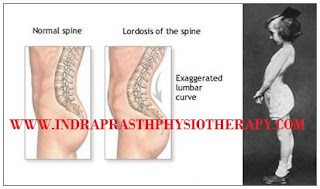Lower-Crossed Syndrome (LCS) - .
In LCS, tightness of the thoracolumbar extensors on the dorsal side
crosses with tightness of the iliopsoas and rectus femoris. Weakness of
the deep abdominal muscles ventrally crosses with weakness of the
gluteus maximus and medius. This pattern of imbalance creates joint
dysfunction, particularly at the L4-L5 and L5-S1 segments, SI joint, and
hip joint. Specific postural changes seen in LCS include anterior
pelvic tilt, increased lumbar lordosis, lateral lumbar shift, lateral
leg rotation, and knee hyperextension. If the lordosis is deep and
short, then imbalance is predominantly in the pelvic muscles; if the
lordosis is shallow and extends into the thoracic area, then imbalance
predominates in the trunk muscles.
Causes
- Prolonged sitting, particularly with bad posture
- Physical inactivity
- Regular performance of sports and activities that involve an uneven stimulation of the muscles that are involved in LCS
- Poor exercise technique.
- Imbalanced strength training
- Genetic predispositions


